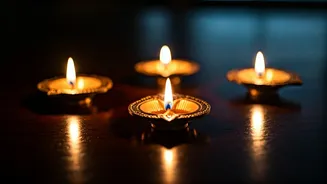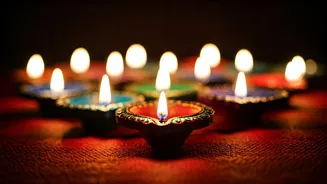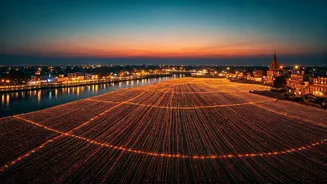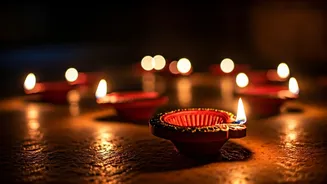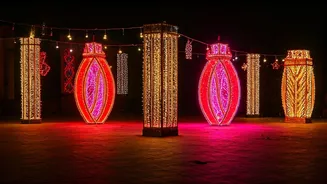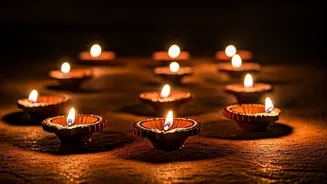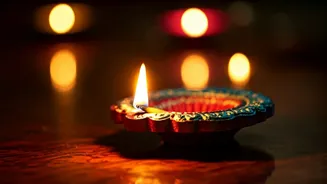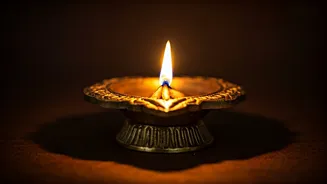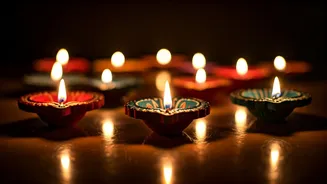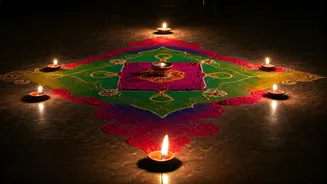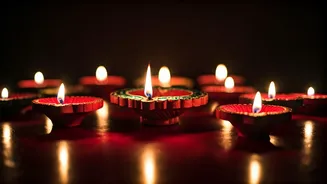Ayodhya's Divine Spark
Ayodhya, a city steeped in religious significance, witnessed the magnificent display of diyas. The diya designs chosen for Ayodhya were more than mere
illuminations; they were expressions of devotion and artistry. The design elements often incorporated traditional motifs, such as lotus flowers, representing purity and enlightenment, along with other symbols reflecting the city's rich heritage. The arrangement of these diyas along the ghats created a mesmerizing spectacle, transforming the space into a canvas of light and shadow. These diyas celebrated not only the festival of Diwali but also the enduring legacy of faith and culture that defines Ayodhya.
Banaras' Spiritual Glow
Banaras, also known as Varanasi, is considered one of the oldest living cities in the world. The ghats of Banaras offered a unique setting for Diwali celebrations, illuminated by carefully curated diya designs. The diyas in Banaras were not simply about lighting; they were about creating a spiritual ambience. Designs frequently depicted intricate patterns and figures, enhancing the spiritual experience. The reflections of the diyas in the sacred waters of the Ganges River further enhanced the overall effect, adding a layer of enchantment to the already captivating ambiance. The combination of artistry and spirituality in Banaras’ diya arrangements showcased the enduring blend of tradition and devotion.
Lotus Motif Delights
The lotus flower played a prominent role in many of the diya designs. The lotus is a symbol of purity, enlightenment, and rebirth, making it a perfect emblem for the auspicious occasion of Diwali. The diya designs often featured the lotus flower at the center, with the light emanating from the petals. The lotus, with its ability to rise above muddy waters, represents the triumph of good over evil, darkness into light. This design element added a layer of profound meaning to the celebrations, inviting viewers to reflect on the deeper spiritual significance of Diwali. The incorporation of lotus motifs was a consistent element across different locations, highlighting the unifying power of symbolism.
Intricate Geometric Patterns
Geometric patterns offered another dimension of beauty and sophistication. These patterns, meticulously crafted, provided visual appeal while paying tribute to the artistic skills and heritage of the community. Complex arrangements of lines, shapes, and forms created dynamic displays that caught the eye and captivated onlookers. Each arrangement was a testament to the dedication and precision of the artists, highlighting the value placed on precision. The interplay of light and shadow across these geometric designs created a visual symphony, turning the ghats into spaces of artistic expression. The utilization of these geometric forms showcased the commitment to innovation and beauty.
Cultural Symbolism Flourishes
The diya designs were rich in cultural symbolism. They went beyond aesthetics; they conveyed stories and values that are integral to Diwali. The use of specific colors, shapes, and figures reflected regional variations and local customs. In addition to lotus flowers and geometric forms, designs included other auspicious symbols, like the swastika, signifying good fortune and well-being. The selection of materials, like clay, oil, and wicks, underscored the sacredness of the festival. These designs were more than decorations; they were the embodiment of cultural identity, expressing India’s rich cultural and artistic tradition. The diya designs served as powerful reminders of the enduring strength of faith and community, fostering a sense of togetherness.
